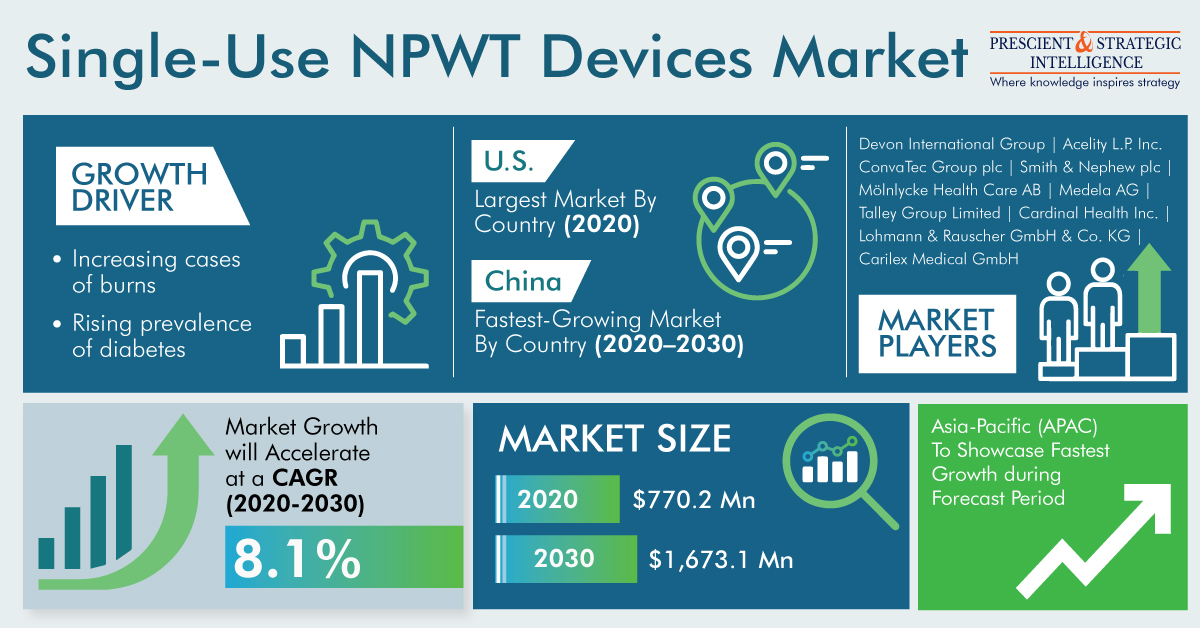Wounds are perhaps the most-common form in which an injury is visible. They can range from minor scrapes and cuts to those that tear the flesh and expose the bone. While nothing normally needs to be done for minor wounds, the major ones don’t heal as quickly on their own. Moreover, unhealed wounds accumulate pus and ultimately become a breeding ground for microbes, which can lead to gangrene, requiring the entire affected tissue to be removed. In extreme cases, gangrene results in limb and arm amputations.
As a result of the growing awareness on the dangers of open wounds, P&S Intelligence predicts the single-use NPWT devices market revenue to reach $1,673.1 million by 2030 from $770.2 million in 2020, at an 8.1% CAGR between 2020 and 2030. This is because since the 1990s, NPWT has become a preferred advanced wound care solution, especially for long-lasting wounds. The term ‘negative pressure’ implies that unlike conventional wound healing techniques, it doesn’t press on the wound; rather pulls at it, thereby sucking out the exudate.
The system contains a suction pump, which creates a vacuum above the wound. The drop in air pressure outside sucks the pus and other fluids out of the wounds via a tube, which are then collected in a bag attached to the pump. Apart from these, the system contains sterile dressings that help attach the tube to the wound and keep the surrounding area clean and unaffected. NPWT is being widely used to treat surgical wounds, burns, lacerations, pressure ulcers, diabetic ulcers, venous ulcers, and wounds caused by carcinomas, amputations, melanomas, and other kinds of trauma.
Currently, this technique is majorly utilized for the treatment of surgical wounds because of the rising incidence of such issues. The surgery volume is skyrocketing across the globe due to an increase in the prevalence of several chronic and acute diseases, accidents, and violence. Moreover, a lot of people go for aesthetic surgeries, such as breast augmentation, which can also lead to post-surgical wounds. Similarly, the rising number of Caesarean-section births is leading to a rising incidence of post-operative wounds, thereby propelling the usage of NPWT.
In regards to single-use NPWT, it is the surging cases of hospital-acquired infections (HAIs) that are propelling their usage. As conventional variants are used on multiple patients, they can easily transmit infections from one patient to another, many of them deadly ones. The World Health Organization (WHO) says that “Of every 100 hospitalized patients at any given time, 7 in developed and 10 in developing countries will acquire at least one health care-associated infection.”. This not only leads to a high mortality burden, but it can also lead to millions in losses for healthcare settings if the allegations of negligence are proved.
Hence, North America is the largest single-use NPWT devices market in the world, because not only is its healthcare infrastructure highly advanced, but the regulations on HAI prevention are also among the strongest here. Moreover, the continent has a high incidence of chronic diseases that cause wounds on their own or as a result of surgeries. Similarly, Asia-Pacific (APAC) is embracing this technique with the increasing investments in its healthcare sector, rising burden of diseases, and an already-high incidence of burns and road accidents.
Hence, with the advancing medical sector, the adoption of single-use NPWT devices will grow.

